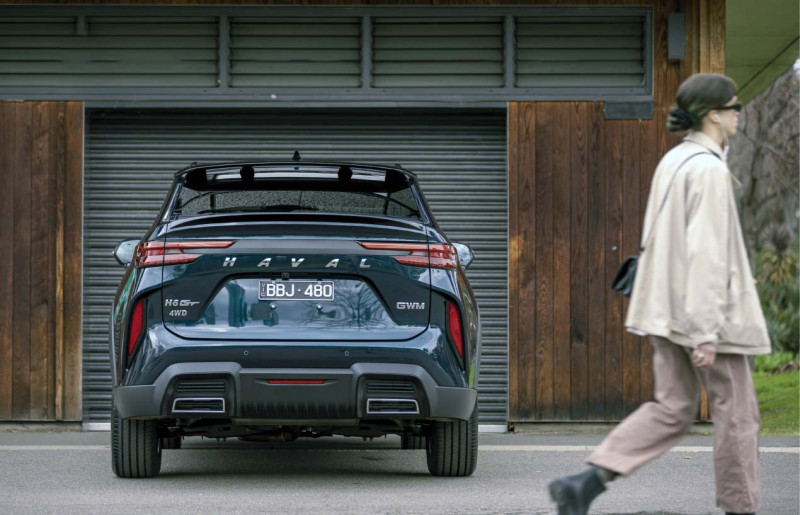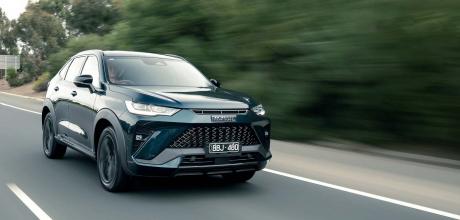2023 Haval H6GT Ultra
Yes, the ‘thrift-shop Urus’ jokes started coming thick and fast as soon as the 2023 Haval H6GT Ultra rolled into the car park, but almost as soon as they started, the office japers went a bit quiet.
NEVER MIND THE WIDTH, FEELTHE QUALITY
This is a well-equipped all-wheel-drive SUV with 150kW and a seven-speed dual-clutch that comes with a seven-year warranty and leaves plenty of change from fifty grand. Can an SUV that seems almost unbeatable on paper cut it against some very capable rivals? The $46,490 on the road ask might be something of a shock if you mentally pigeonhole Havals in the midthirties, but bear with me here.

It’s certainly big enough. At 4727mm long and riding on a 2738mm wheelbase, the H6GT is a good 177mm longer than a Mazda CX-5, with 38mm more between the wheels and 127mm longer than a Toyota RAV4, with a 48mm longer wheelbase. It’s even longer than a seven-seat Skoda Kodiaq and is therefore right up near the top of the medium SUV category.
This all-wheel drive Ultra is the range-topping H6GT, sitting above a $40,990 (drive-away) front-wheel drive Lux trim. With the exception of wireless Apple CarPlay/Android Auto, it’s hard to fault the equipment list. In Ultra guise it gets heated and ventilated leather and suede front seats, a wireless charging pad, Michelin tyres, heated leather steering wheel, a head-up display, electric panoramic sunroof, an electrically-opening kick tailgate and automated parking.

That’s on top of kit that’s common with the Lux model including a 12.3-inch central screen, wired Apple CarPlay/Android Auto, 19-inch alloy wheels, a surround-view parking camera, an eight-speaker stereo and a generous suite of safety features.
Given that a 1.5-litre 131kW Honda Civic until recently retailed at $47,200, it’s not hard to see value in the $46,490 drive-away that Haval asks of the H6GT Ultra. Its closest rival is probably Ford’s Escape in ritzy Vignale AWD guise, which packs more grunt but which is a hefty $49,590 plus on-roads, comes with a mere five-year warranty and lacks many of the Ultra’s equipment highlights.

I hadn’t been behind the wheel of an H6 before and wasn’t expecting much, but the interior finish on this Ultra is as good or better than many mainstream rivals. The materials feel better finished than a a lot of mainstream tackle, about par with Hyundai and Kia but still a little way off Mazda and Volkswagen in terms of perceived quality. That’s quite a mark for Haval to have hit.
Of course, much will depend on how offended you are by the softtouch carbonfibre-look material that lines its dash. Personally, I’m not particularly affronted by it, and there’s suede detailing on the door cards and centre console. The dash architecture is interesting with a large 12.3-inch central tablet-style display and another smaller 10-5-inch screen ahead of the driver.
The steering wheel isn’t overburdened by controls and is a decent size with a rim that doesn’t feel as if you’re trying to subdue an ornery carpet python. The sports seats aren’t as supportive as perhaps they should be, offering a fairly flat base and a narrow upper section, with a tiny head restraint. There are some other ergonomic shortcomings too, such as the USB data socket being virtually on the floor on the passenger side of the centre stack. Corner the H6GT with any gusto and a wired phone will launch out of either the lower tray or the charging pad and end up in the passenger footwell.
The infotainment features a huge suite of menus and functions, but screen response is poor and you’ll often need to jab at a menu function two or three times before it registers. When you’re running Android Auto or Apple CarPlay, it occupies the entire screen and performing a task as simple as changing the interior temperature then requires pressing a physical air conditioning control button to first disable the phone screen mirroring, then to change the temperature (which requires jabbing at a small icon to adjust it in half-degree increments) before finally having to switch to the apps screen so you can relaunch the phone screen mirroring.
Accessing the air-con screen via a physical button seemed to be the only way to switch out of Android Auto and reach the menus for other vehicle functions. If there’s a more efficient method it escaped us.
Visibility out of the slot-like rear window is compromised, and not helped by the fact that there’s no rear wiper. Likewise, the rear three-quarter visibility isn’t helped by the chunky pillars. Fortunately, the H6GT has an excellent surround-view monitor but in this case, it feels as though electronics are making up for a design that has, in terms of visibility, prioritised styling over practicality.
The sporty silhouette leads you to think that the rear seats might well be a bit cramped, but I could easily sit behind my driving position with knee room to spare, helped by the fact that it’s easy to get your feet under the front seats. Headroom is acceptable too, with my 193cm frame easily able to sit comfortably.
The boot’s pretty compact at 392 litres compared to the 600 litres of the regular H6 SUV. A Ford Escape offers a little more at 412 litres, but a RAV4 measures 580 litres and a Skoda Kodiaq nets you 630 litres. Flip the rear seats down and you have up to 1392 litres.
If there’s a sub-$50K medium SUV that’s better fun than the Haval H6GT Ultra to fling up a challenging road, I haven’t driven it. In order to tap into the main vein of talent, there are a few pre-requisites. Firstly, you’ll need to disable the maddening emergency lane-keep function. That is unless you want your drive to be perpetually interrupted with chimes, wheelgrabbing and ‘ELK Activated’ flashing up on the dash as if you’ve stimulated a moose. It activates if you come within a sniff of a line and even intervenes – bizarrely – on dirt roads. Quashing this distraction requires locating a submenu set four-deep in the structure and it needs disabling on every trip, bringing its safety benefit into question. It’s also worth disabling the idle-stop function, which has all the reactions of a darted sloth. Fortunately, the Haval remembers this preference. You’ll also need to switch out of the Normal drive mode. This is fine for ambling along but on a decent road it’ll often exit a corner in sixth or seventh gear, so when you throttle on to tap into some power it’ll kick down to third and lurch horribly.
Switch into Sport instead and the H6GT will flash its hazard lights in acknowledgement, which scotches your chances of a sneaky traffic light getaway. Why? In Normal mode, you’ll also need to give the throttle quite a poke to get the car moving away from the line, which can prove tedious.
Wholly unexpectedly, there’s also a Race mode (alongside Off Road, Snow, Sand and Eco modes) which sharpens things up significantly.
Proceed through all of these steps and the underlying excellence of the chassis dynamics makes itself apparent. All of these fundamentals are very good indeed, despite the H6GT being built on a platform called the Lemon. Ride quality is fir-mish but never brittle or terse. The steering is communicative and the brakes reassuring, despite an initially over-servoed feel to the pedal. The BorgWarner Haldex all-wheel-drive system means that you’ll be able to apply power cleanly on corner exit without eliciting unseemly traction control interventions.
The 8.4L/100km for the H6GT Ultra is helped by the fact that it weighs 1675kg, which isn’t bad at all for a vehicle of this size. In fact, there are Porsche 911s that weigh more. It’s also around 100kg less than the shorter, lower and narrower Skoda Kodiaq. Five-star ANCAP rated, the H6GT scored 90 percent in adult occupant protection, 88 percent in child occupant protection, 73 percent in vulnerable road user protection (pedestrians/cyclists), and 81 percent in safety assist (advanced technology). The H6GT’s adaptive cruise control works very well with the lane-keep while freeway driving, helping the vehicle stay centred in its lane.
I’d describe the Haval H6GT as a bit of a mixed bag of qualities. I had initially assumed that the electronic interface would be very clever while the nuts and bolts of chassis engineering would leave a bit to be desired. The opposite is the case.
The bones of the vehicle are excellent. The whole go, stop and steer thing is very well resolved, and the packaging, equipment provision and pricing are pretty much spot-on for a vehicle of this ilk. Look closer at the details of how you interact with the H6GT on a daily basis and it’s apparent that the final finishing of infotainment and driver-assist systems need finessing. Haval has, in many regards, delivered 90 percent of a very good vehicle that’s been let down by a cornucopia of petty frustrations. All of these can fairly easily be fixed, so a facelifted version of the H6GT has the potential to be very good indeed. In the meantime, I’d try before you buy.
Above: Opt for the Ultra model and you’ll also get a 12v socket in the luggage bay. Wheelarch intrusion limits the utility a little but loading lip is low and the tailgate is powered.
If there’s a sub-$50k medium SUV that’s better fun to fling up a challenging road, I haven’t driven it
PLUS MINUS
Decent chassis dynamics; stacks of features; sharply styled interior and exterior
Intrusive safety systems; dull-witted infotainment; gearbox calibration in default mode.
TECHNICAL DATA Model 2023 Haval H6GT Ultra
- Engine 2.0-litre 4cyl, dohc, 16v, turbo
- Max power 150kW @ 6000-6300rpm
- Max torque 320Nm @ 1500-4000rpm
- Transmission 7-speed dual clutch
- Weight 1675kg
- 0-100km/h 8.8sec (claimed)
- Economy 8.4L/100km
- Price $46,490 (drive away)
- On sale Now


